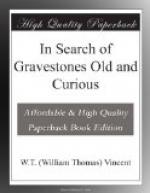Fig. 69.—At old Bexley.
“To Susannah, wife of Henry
Humphrey,
died 26th December 1805, aged 57 years.”
The anchor stands for Hope, the draped urn signifies mourning for the dead, and the figure reading the Holy Book suggests consolation. From Bexley Church to the railway station was but a brief space. The day’s tramp was ended.
[Illustration: Fig. 68. Foot’s Cray.]
[Illustration: Fig. 69. Bexley.]
CHAPTER VI.
More typical tramps.
How far county divisions might affect the early fashions in gravestones was one of my first questions, and, having seen much of Kent, time was soon found for a scamper through the country bordering Epping Forest and along the backbone of Essex.
At Barking, just within the old Abbey gate, I came upon an enigmatical illustration.
Fig. 70.—At Barking.
Inscription illegible. Date appears to be 1759.
The signification of the four balls I am unable to suggest, unless they be connected in some way with the planetary system and point man’s insignificance. They appear to emanate from a cloud resting upon the hour-glass, and may help the other emblems in symbolizing time and eternity. The nickering candle is also of doubtful interpretation. It may mean the brevity of life; it can hardly be needed, in the presence of the skull, to indicate death. The candle is sometimes employed alone, occasionally extinguished. At Woolwich there is an instance in which the candle is in the act of being put out.
Fig. 71.—At Woolwich.
“To Siston Champion, died 27th Feb.
1749-50
(a few days after
the birth of her child),
aged 28 years.”
The candle is indeed commonly used as a simile of life’s uncertainty in all countries, and it may be that where it is represented in a state of burning it may be meant as a lesson on the number of our days. It is seen with the skulls in the churchyard of St. Nicholas, Deptford, and other places.
Fig. 72.—At Deptford.
“To William Firth, died 1724, aged 21 years.”
In West Ham Churchyard may be seen the figure of the kissing cherubs rather prettily rendered, but to be found in various forms in many places, and always expressive of affection.
Fig. 73.—At west Ham.
“To Sarah Moore, died 1749.”
Wanstead Churchyard is remarkable for the abundance and originality of its old gravestones. Here is one (Fig. 74) which carries more distinctly the fanciful idea suggested at West Ham (page 34, Fig. 63); flowers and foliage, and even fruit, combining with the lowered torch and summoning trumpet to tell of life beyond the grave.




